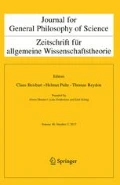Abstract
In the late 19th century great changes in theories of light and electricity were in direct conflict with certitude, the view that scientific knowledge is infallible. What is, then, the epistemic status of scientific theory? To resolve this issue Duhem and Poincaré proposed images of fallible knowledge, Instrumentalism and Conventionalism, respectively. Only in 1919–1922, after Einstein's relativity was published, he offered arguments to support Fallibilism, the view that certainty cannot be achieved in science. Though Einstein did not consider Duhem's Instrumentalism, he argued against Poincaré's Conventionalism. Hitherto, Einstein's Fallibilism, as presented at first in a rarely known essay of 1919, was left in the dark. Recently, Howard obscured its meaning. Einstein's essay was never translated into English. In my paper I provide its translation and attempt to shed light on Einstein's view and its context; I also direct attention to Einstein's images of philosophical opportunism in scientific practice.
Similar content being viewed by others
BIBLIOGRAPHY
Archives
Albert Einstein's Archives at the Hebrew University of Jerusalem referred to as EA.
Karl Popper's Archives at the Hoover Tower at Stanford University referred to as PA.
Sources
Agassi, J.: 1975, Science in Flux, Boston Studies in the Philosophy of Science. Vol. XXVIII. Boston: D. Reidel.
Born, M.: 1971, Born-Einstein Letters. (trans. from the German ed. of 1968). N.Y.: Walker.
Brian, D.: 1996, Einstein: A Life. N.Y.: John Wiley & Sons.
Duhem, P.: 1904-5, La théorie physique: son objet sa structure. Paris, 1906, 2d. ed. 1914. The Aim and Structure of Physical Theory. trans. P.P. Wiener. Princeton, N.J.: Princeton University Press, 1954.
Duhem, P.: 1908, ∑ΩZEIN TA ΦAINOMENA, Essai sur la notion de théorie physique de Platon à Galilée. APC:156:113-39, 277-302, 352-77, 482-514, 561-92. Appeared under the same title in a book: Paris: Hermann, To Save the Phenomena. trans. E. Doland & C. Maschler. Chicago: Chicago University Press, 1969.
Earman, J. and Glymour, C.: 1980, Relativity and eclipses: The British eclipse expeditions of 1919 and their predecessors, HSPS, 11:1, 48-85.
Einstein, A.: 1905 Einstein's Miraculous Year: Five Papers that Changed the Face of Earth. ed. J. Stachel. Princeton: Princeton University Press, 1998.
Einstein, A.: 1917, Ueber die spezielle und die allgemeine Relativitätstheorie, Gemeinverständlich, Braunschweig: Vieweg.
Einstein, A.: 1920, Relativity. trans. of Einstein [1917] with an additional appendix III “The Experimental Confirmation of the General Theory of Relativity”. trans. R.W. Lawson, N.Y.: Henry Holt & Co.
Einstein, A.: 1919, “Induktion und Deduktion in der Physik”. Berliner Tageblatt (Suppl. 4:1), 25 December.
Einstein, A.: 1922, “Geometry and Experience”, 1921. Translated and expended version was published in Sidelights on Relativity.
Einstein, A.: 1933, On the Method of Theoretical Physics. Oxford: The Clarendon Press.
Einstein, A.: 1949, “Reply to Criticisms” in Schilpp [1949].
Eisenstaedt, J.: 1989, “Low water mark in General Relativity”, in J. Stachel & D. Howard, eds., Einstein Studies. Einstein and the History of Relativity.
Holton, G.: 1988, Thematic Origins of Scientific Thought. Harvard: Harvard University Press, Rev. ed.
Howard, D.: 1984, “Realism and Conventionalism in Einstein's Philosophy of Science: The Einstein-Schlick Correspondence”, Philosophia Naturalis 21: 616-29.
Howard, D.: 1990, “Einstein and Duhem”, Synthese 83: 363-84.
Pais, A.: 1994, Einstein Lived Here. Oxford: Oxford University Press.
Paty, M.: 1993, Einstein philosophe. Paris: Presses Universitaires de France.
Poincaré, H.: 1891, Électricité et Optique. 2d. Rev. ed. Paris, 1901. Trans. of its 1st ed. Into German under the title: Elektricität und Optik. Berlin: Verlag von Julius Springer.
Poincaré, H.: 1905, Science et Hypothese. Paris, 1902. Science and Hypothesis. trans. W.J.G. N.Y.: The Walter Scott Pub. Co.
Popper, K.: 1935, Logik der Forschung. Wien: Verlag von J. Springer.
Popper, K.: 1976, Unended Quest. La Salle. III: Open Court.
Popper, K.: 1979, “Revolution in the idea of knowledge”, unpublished Frank Nelson Doubleday Lecture. No. 4, April 10th. PA 6-10.
Popper, K.: 1996, “Einstein's influence on my view of science”, BBC Broadcast: Given on February 23rd; unpublished. PA 82-17.
Schilpp, P.A. ed.: 1949, Albert Einstein. Philosopher-Scientist. Evanston, III. Library of Living Philosophers.
Schlick, M.: 1920, Space and Time. 2d. Ed. Trans. H.L. Brose, N.Y.: Oxford University Press.
Rights and permissions
About this article
Cite this article
Adam, A.M. Farewell to certitude: Einstein's novelty on Induction and Deduction, Fallibilism. Journal for General Philosophy of Science 31, 19–37 (2000). https://doi.org/10.1023/A:1008380527490
Issue Date:
DOI: https://doi.org/10.1023/A:1008380527490


